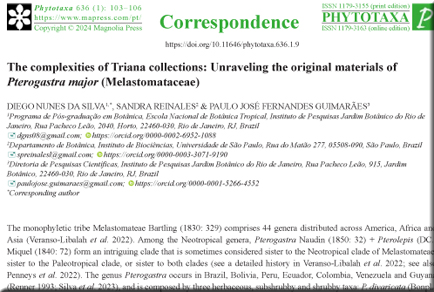Abstract
The monophyletic tribe Melastomateae Bartling (1830: 329) comprises 44 genera distributed across America, Africa and Asia (Veranso-Libalah et al. 2022). Among the Neotropical genera, Pterogastra Naudin (1850: 32) + Pterolepis (DC.) Miquel (1840: 72) form an intriguing clade that is sometimes considered sister to the Neotropical clade of Melastomateae, sister to the Paleotropical clade, or sister to both clades (see a detailed history in Veranso-Libalah et al. 2022; see also Penneys et al. 2022). The genus Pterogastra occurs in Brazil, Bolivia, Peru, Ecuador, Colombia, Venezuela and Guyana (Renner 1993; Silva et al. 2023), and is composed by three herbaceous, subshrubby and shrubby taxa: P. divaricata (Bonpl.) Naudin (1850: 33), P. divaricata var. glabra (Gleason) Renner (1994: 68), and P. minor Naudin (1850: 33) (Renner 1994). Pterogastra major Triana (1872: 40), a heterotypic synonym of P. divaricata (Renner 1994), was described based on at least four collections: Bonpland s.n. collected next to Villavicencio (Colombia), Goudot s.n. collected in Chaparral (Colombia), Triana s.n. probably collected in Fusagasugá and Susumuco (Colombia), and Mathews 1278 collected next to Moyabamba (Peru). In the taxonomic revision of the genus, the specimen Triana s.n. deposited at BM was selected as the lectotype of Pterogastra major (Renner 1994). Nevertheless, after investigating the Triana collections associated with the original material of P. major and based on the information contained in each label, we reassessed the nomenclatural status of each exsiccate, providing clarifications for all materials of this species collected by Triana.
References
- Bartling, F.G. (1830) Ordines naturales plantarum eorumque characteres et affinitates adjecta generum enumeratione. Sumtibus Dieterichianis, Gottingae [Göttingen], 498 pp.
- Candolle, A.P. (1828) Melastomaceae. In: Candolle, A.P. (Ed.) Prodromus systematis naturalis regni vegetabilis, sive enumeratio contracta ordinum, generum, specierumque plantarum huc usque cognitarum, juxta methodi naturalis normas digesta. Vol. 3. Sumptibus Sociorum Treuttel et Würtz, Parisiis [Paris], pp. 99–202. https://doi.org/10.5962/bhl.title.286
- Dugand, A. (1944) Itinerarios botánicos de José Jerónimo Triana. Revista de la Academia Colombiana de Ciencias Exactas, Físicas y Naturales 5: 483–489.
- Humboldt, F.W.H.A. & Bonpland, A.J.A. (1812) Voyage de Humboldt et Bonpland. Monographie des Melastomacées. Rhexies. Libreria Graeco-Latino-Germanica, Paris, pp. 57–68. https://doi.org/10.5962/bhl.title.16027
- Humboldt, F.W.H.A. & Bonpland, A.J.A. (1823) Voyage de Humboldt et Bonpland. Monographie des Melastomacées. Rhexies. Libreria Graeco-Latino-Germanica, Paris, pp. I–II + pp. 137–158. https://doi.org/10.5962/bhl.title.16027
- Instituto de Ciencias Naturales (2022) Herbario Virtual José Jeronimo Triana. Facultad de Ciencias, Universidad Nacional de Colombia. Available from: http://herbariotriana.unal.edu.co/en/rutasmapa/ (accessed 12 November 2023)
- Kirkbride, J.H., Jr. (1982) Rubiaceae types in the Triana collections at the Instituto de Ciencias Naturales, Universidad Nacional, Bogotá, Colombia. Taxon 31: 303–307. https://doi.org/10.2307/1219996
- Lester, R. (1997) Typification of nineteen names of African Solanum species described by A. Richard and others, including S. campylacanthum and S. panduriforme. Botanical Journal of the Linnean Society 125: 273–293. https://doi.org/10.1111/j.1095-8339.1997.tb02258.x
- Martius, C.F.P. & Eichler, A.G. (1885) Flora brasiliensis, enumeratio plantarum in Brasilia hactenus detectarum: quas suis aliorumque botanicorum studiis descriptas et methodo naturali digestas partim icone illustratas. Vol. 14. Frid. Fleischer, Monachii et Lipsiae [Munich & Leipzig], pp. 205–510. https://doi.org/10.5962/bhl.title.454
- Miquel, F.A.G. (1840) Commentarii phytographici, quibus varia rei herbariae capita illustrantur. Apud S. et J. Luchtmans, Lugduni Batavorum [Leiden], 146 pp. https://doi.org/10.5962/bhl.title.13717
- Naudin, C.V. (1850) Melastomacearum quӕ in Musӕo Parisiensi continentur. Monographicӕ descriptionis et secundum affinitates distributionis tentamen. (sequentia.). Annales des Sciences Naturelles, Botanique sér. 3 13: 25–39.
- Penneys, D.S., Almeda, F., Reginato, M., Michelangeli, F.A., Goldenberg, R., Fritsch, P.W. & Stone, R.D. (2022) A new Melastomataceae classification informed by molecular phylogenetics and morphology. In: Goldenberg, R., Michelangeli, F.A. & Almeda, F. (Eds.) Systematics, Evolution, and Ecology of Melastomataceae. Springer, Switzerland, Cham, pp. 109–165. https://doi.org/10.1007/978-3-030-99742-7_5
- Reinales, S. & Parra-O., C. (2022) Disentangling the historical collection of José Jerónimo Triana from the República de la Nueva Granada between 1851 and 1857. Taxon 71: 420–439. https://doi.org/10.1002/tax.12653
- Renner, S.S. (1994) Revisions of Pterogastra and Schwackaea (Melastomataceae: Melastomeae). Nordic Journal of Botany 14: 65–71. https://doi.org/10.1111/j.1756-1051.1994.tb00574.x
- Silva, D.N., Braga, J.M.A., Afonso, E.A.L., Reinales, S., Cantuária, P.C., Rocha, M.J.R., Guimarães, E.F. & Guimarães, P.J.F. (2023) New records for different lineages of Melastomataceae in the Brazilian Amazon. Acta Amazonica 53: 336–346. https://doi.org/10.1590/1809-4392202300472
- Sprengel, C. (1825) Rhexia. In: Linnaei, C. (Ed.) Systema vegetabilium. Vol. 2. Sumtibus Librariae Dieterichianae, Gottingae [Göttingen], pp. 305–311. https://doi.org/10.5962/bhl.title.822
- Triana, J.J. (1872) I. Les Mélastomacées. Transactions of the Linnean Society of London 28: 1–188. qhttps://doi.org/10.1111/j.1096-3642.1871.tb00222.x
- Turland, N.J., Wiersema, J.H., Barrie, F.R., Greuter, W., Hawksworth, D.L., Herendeen, P.S., Knapp, S., Kusber, W.-H., Li, D.-Z., Marhold, K., May, T.W., McNeill, J., Monro, A.M., Prado, J., Price, M.J. & Smith, G.F. (2018) International Code of Nomenclature for algae, fungi, and plants (Shenzhen Code): Adopted by the Nineteenth International Botanical Congress Shenzhen, China, July 2017. Regnum Vegetabile 159. Koeltz Botanical Books, Glashütten. https://doi.org/10.12705/Code.2018
- Veranso-Libalah, M.C., Stone, R.D., Kadereit, G. & Guimarães, P.J.F. (2022) Systematics and Taxonomy of the tribe Melastomateae. In: Goldenberg, R., Michelangeli, F.A. & Almeda, F. (Eds.) Systematics, Evolution, and Ecology of Melastomataceae. Springer, Cham, pp. 429–463. https://doi.org/10.1007/978-3-030-99742-7_21


